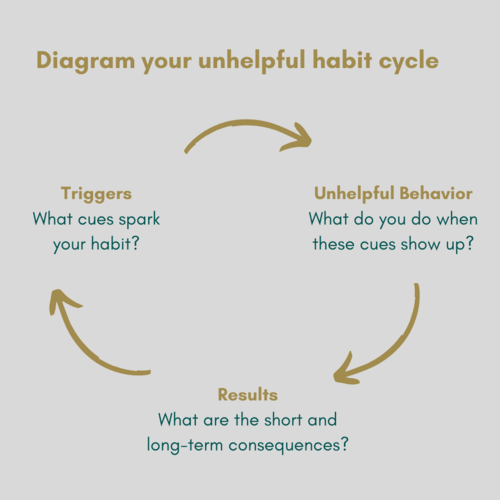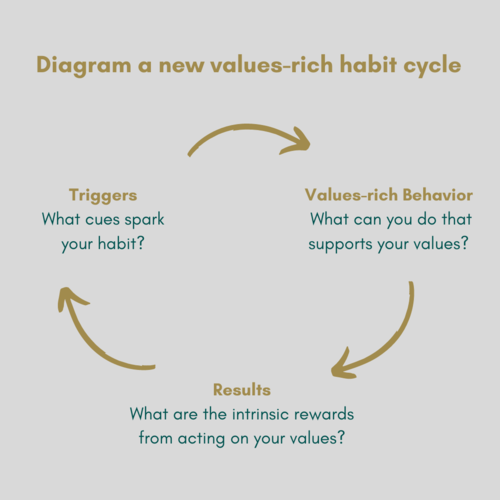Recently I’ve found myself picking up my phone and checking it—way too much. Whether I’m feeling anxious, lonely, or mildly uncomfortable, I check—“There’s something in here that’ll help me feel better!”
I’ve formed an unhelpful habit cycle—one that is interfering with what I care about, like looking my kids in the eyes.
ACT calls this type of habit loop experiential avoidance—often our attempts to avoid the discomfort of living through distracting, numbing out, or controlling our inner experience can derail us from our values.
That’s why I was thrilled to interview Dr. Judson Brewer (Dr. Jud), a neuroscientist at Brown University and author of The Craving Mind: From Cigarettes to Smart Phones—Why We Get Hooked and How We Can Break Bad Habits. (Listen to the full episode.)
Dr. Jud uses cutting edge neuroscience to understand what’s happening in the brain when we are in habit cycles, and how to use mindfulness and meditation to get unhooked.
In this post I share some of Dr. Jud’s teachings as well as some tips from behavior science and ACT to help you:
- deconstruct unhelpful habits
-
reconstruct values-rich habits
Download my 6 steps to help you design your own values-rich habits to help you grow the life you want to grow.
The Neuroscience of Habits
A lot of our habits are unconscious. We don’t even realize we are doing them. Habits also incredibly difficult to control when we’re stressed. As Dr. Jud described in our interview, “our prefrontal cortex of our brain goes offline” when we’re hungry, angry, lonely, or tired (HALT).
Trying to think your way out of anxiety or a craving doesn’t work.
Other key points from Dr. Jud:
-
Everyday habits like overeating or worrying activate the same reward pathways in the brain as drugs of abuse
-
The orbital frontal cortex of your brain constantly updates the reward values of habits, leading you to choose chocolate over broccoli
-
Bringing curiosity and mindfulness to your cravings changes your relationship with them and de-activates brain areas involved in craving
Habit Cycles
Habits aren’t just things we do with our hands and feet. We can also have mental habits like worrying, ruminating or judging.
Whether you’re grabbing a glass of wine while cooking or re-playing your worst relationship break-up, habits follow a simple pattern: Trigger → Behavior → Results.
Triggers are cues that spark our habits. We have triggers both outside of our skin (e.g., your phone pings a notification) and under our skin (e.g., anxiety, craving, stress).
Behaviors are what we do when the triggers show up. Do you pick up your phone, eat the cookie, snap at your co-worker? Often we don’t even realize we’re in a habit until we’re already doing it.
Results are what happens after you engage in the behavior. Whereas triggers spark your habit, results are what fans the flame to keep it going. Our brain gives more preference to short-term rewards over long-term ones. And our most rewarding habits give us pleasure while distracting us from the discomfort of living.
To learn more about habit loops, read Atomic Habits by James Clear, and The Power of Habit by Charles Duhigg, or watch how Stanford habit guru BJ Fogg creates lasting change with “tiny habits.” Dayna-Lee Baggly’s book Healthy Habits Suck is great for changing your health behaviors and DJ Moran has great things to say about how to use the ACT process of Committed Action to promote change.

Get Curious About Your Habits
Getting curious with mindfulness can change your relationship with your cravings and gives you more space to choose your actions wisely.
Dr. Jud describes how curiosity changes our relationship with cravings. Try getting more curious about:
1. Your habit cycle: The next time you’re doing your unhelpful habit, observe it. What triggers your habit? What behaviors are you doing? What happens after you engage in your habit? What are the short and long term consequences?
2. Your triggers. Get open and take more accepting stance toward cravings, sensations, and difficult emotions. Ride your craving like a wave, and allow your thoughts to pass like leaves on a stream
3. The results. Pay more attention to the negative consequences of your behavior. Change it’s reward value by bringing awareness to how it’s not helpful to you or the aspects of it that aren’t truly satisfying.
Build Values-Rich Habits
Once you’ve developed a curious, mindful stance with your unhelpful habit, you can choose a more helpful one—one that is based on your values. Daily values-rich actions, like those taught in ACT, builds healthier relationships, increases commitment to health behaviors, and improves work performance.
Values-rich habits are intrinsically rewarding and self-reinforcing. The more you do them, and focus on the rewarding feelings associated with acting on your values, the more you will want to continue them!
Build a Values-Rich Habit Cycle: Trigger → Values-based Action → Intrinsic reward. Here are 6 steps to help you design your own values-rich habit cycle.

Here’s my old unhelpful habit cycle: Anxious → look at my phone → feel short term relief but long term disconnection
Here’s what I’m committing to do:
My new values-rich habit cycle: Anxious → look at whomever I’m within the eye and breathe → feel more connected short term and long term
Check out this handy one-page handout that walks you through building values-rich habits in 6 steps.
I hope you found this post helpful. Share it with a friend who you think would want to change unhealthy habits into values-based ones.
Download Podcast Episode Transcript


